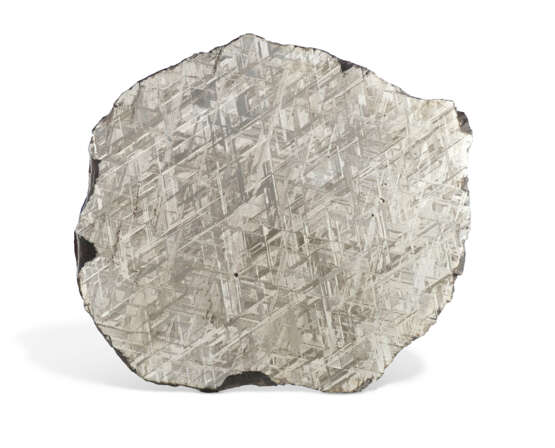A MUONIONALUSTA METEORITE END PIECE — SHIMMERING CRYSTALLINE STRUCTURE IN A METEORITE THAT FELL 1 MILLION YEARS AGO
06.04.2022 14:00UTC +00:00
Classic
Sold
12600GBP £ 12 600
| Auctioneer | CHRISTIE'S |
|---|---|
| Event location | United Kingdom, London |
| Buyer Premium | see on Website% |
Archive
The auction is completed. No bids can be placed anymore.

ID 737542
Lot 53 | A MUONIONALUSTA METEORITE END PIECE — SHIMMERING CRYSTALLINE STRUCTURE IN A METEORITE THAT FELL 1 MILLION YEARS AGO
Estimate value
£ 8 000 – 12 000
Displaying a prominent crystalline latticework, Muonionalusta meteorites are found near the Muonio River in northern Sweden above the Arctic Circle. While meteorite hunters unearthed numerous masses in recent years, it was in 1906 that children discovered the first Muonionalusta specimen while engaging in a favorite childhood pastime: kicking rocks. In this instance an unexpectedly dense rock later was verified to be a meteorite. Possessing what is among the highest terrestrial ages of any meteorite, Muonionalusta fell to Earth about one million years ago, when the region was glaciated—and it has experienced four different ice ages since then. Despite their age, many specimens exhibit only minor interior weathering due both to the stability of the material as well as being preserved in the deep freeze of the Arctic. When sliced and etched, Muonionalusta showcases its resplendent crystalline structure. Also known as a Widmanstätten pattern, this intergrowth of two iron-nickel minerals, kamacite and taenite, forms an unearthly metallic grid in shimmering shades of gray and silver rendered in an otherworldly mosaic. This pattern is also diagnostic in the identification of an iron meteorite; these samples, akin to extraterrestrial steel, cooled extremely slowly in their parent asteroids, typically at rates of a few degrees per million years. No man-made steel has a Widmanstätten pattern and none cooled that slowly. Muonionalusta is also the first iron meteorite in which the mineral stishovite was discovered. Stishovite is a rare and extremely hard silicon dioxide polymorph of quartz that formed under tremendous pressure caused by a hypervelocity impact on the asteroidal parent body.
Christie's would like to thank Dr. Alan E. Rubin at the Department of Earth, Planetary, and Space Sciences, University of California, Los Angeles for his assistance in preparing this catalogue.
240 mm x 200 mm x 33 mm
7.1kg.
| Address of auction |
CHRISTIE'S 8 King Street, St. James's SW1Y 6QT London United Kingdom | |
|---|---|---|
| Preview |
| |
| Phone | +44 (0)20 7839 9060 | |
| Buyer Premium | see on Website | |
| Conditions of purchase | Conditions of purchase |



